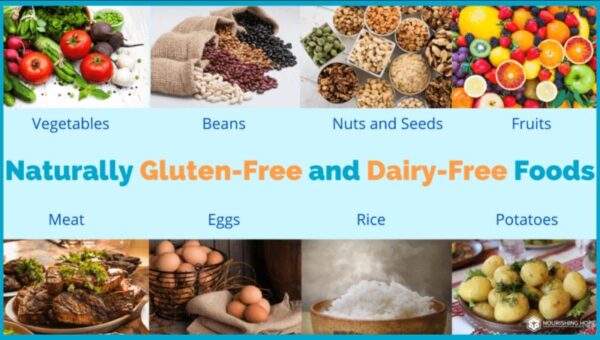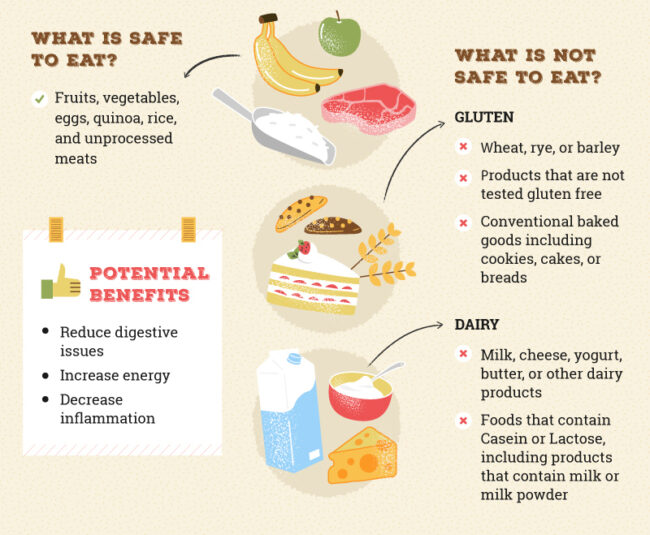In recent years, the gluten and dairy-free diet has gained significant attention, not only among those with allergies or intolerances but also among individuals looking to improve their overall health.

Whether driven by medical necessity or lifestyle choice, many people are exploring the benefits of eliminating gluten and dairy from their diets. In this article, we will delve into what a gluten and dairy-free diet entails, its potential benefits, meal planning tips, and delicious recipe ideas to help you make this dietary transition smoothly.
Understanding Gluten and Dairy
Before diving into the specifics of a gluten and dairy-free diet, it’s essential to understand what gluten and dairy are and why some people need to eliminate them from their diets.
- Gluten: Gluten is a protein found in wheat, barley, rye, and their derivatives. It gives bread its elasticity and helps it rise. People with celiac disease, an autoimmune disorder, must avoid gluten entirely, as it can cause severe health complications. Others may have non-celiac gluten sensitivity, which can lead to digestive issues and other symptoms.
- Dairy: Dairy products include milk, cheese, yogurt, and other products derived from animal milk. Some individuals are lactose intolerant, meaning they have difficulty digesting lactose, the sugar found in milk, which can cause bloating, gas, and diarrhea. Others may have a milk allergy, which can result in severe reactions.
The Benefits of a Gluten and Dairy-Free Diet

- Improved Digestion: Many people report better digestive health after eliminating gluten and dairy from their diets. For those with intolerances or sensitivities, removing these foods can reduce bloating, gas, and discomfort.
- Increased Energy Levels: Some individuals find that once they eliminate gluten and dairy, they experience more stable energy levels throughout the day. This can be particularly beneficial for those who previously struggled with fatigue or brain fog.
- Reduced Inflammation: Gluten and dairy can contribute to inflammation in some people, leading to conditions such as arthritis or skin issues. A gluten and dairy-free diet may help reduce inflammation and alleviate associated symptoms.
- Better Skin Health: For some, dairy is linked to acne and other skin problems. By cutting out dairy, individuals may see improvements in their skin clarity and texture.
- Weight Management: A gluten and dairy-free diet can promote weight loss by encouraging the consumption of whole, unprocessed foods. When these food groups are eliminated, individuals often turn to fruits, vegetables, lean proteins, and healthy fats.
How to Transition to a Gluten and Dairy-Free Diet
Transitioning to a gluten and dairy-free diet can seem daunting at first, but with careful planning and the right resources, it can be a smooth process. Here are some steps to help you get started:
- Educate Yourself: Familiarize yourself with gluten and dairy-containing foods. Learn to read labels and identify hidden sources of gluten and dairy in packaged foods.
- Plan Your Meals: Create a weekly meal plan that includes gluten and dairy-free recipes. Planning ahead can help you avoid the temptation to reach for processed or convenience foods that may contain gluten or dairy.
- Stock Your Pantry: Fill your pantry with gluten and dairy-free staples. Look for alternatives such as almond milk, coconut yogurt, gluten-free grains (like quinoa, rice, and oats), and gluten-free flours (like almond flour or coconut flour).
- Explore Substitutes: Find suitable substitutes for your favorite gluten and dairy products. For example, use nutritional yeast as a cheese substitute, or try gluten-free pasta instead of traditional pasta.
- Experiment with Recipes: Discover new recipes that align with your dietary restrictions. Many online resources and cookbooks specialize in gluten and dairy-free meals, providing inspiration and ideas.
Delicious Gluten and Dairy-Free Recipes
Here are some easy and tasty recipes to get you started on your gluten and dairy-free diet:
Breakfast: Banana Oatmeal Pancakes
Ingredients:
- 1 cup gluten-free rolled oats
- 1 ripe banana
- 2 eggs
- 1/2 teaspoon baking powder
- A pinch of salt
- Optional toppings: maple syrup, fresh fruit, or nut butter
Instructions:
- Blend all the ingredients until smooth.
- Heat a non-stick skillet over medium heat and pour in batter to form pancakes.
- Cook for 2-3 minutes on each side until golden brown.
- Serve with your favorite toppings.
Lunch: Quinoa Salad with Chickpeas
Ingredients:
- 1 cup cooked quinoa
- 1 can chickpeas, rinsed and drained
- 1/2 cucumber, diced
- 1 bell pepper, diced
- 1/4 red onion, chopped
- A handful of fresh parsley, chopped
- Dressing: olive oil, lemon juice, salt, and pepper
Instructions:
- In a large bowl, combine all salad ingredients.
- In a separate bowl, whisk together dressing ingredients.
- Pour the dressing over the salad and toss to combine. Serve chilled or at room temperature.
Dinner: Grilled Chicken with Roasted Vegetables
Ingredients:
- 2 chicken breasts
- 2 tablespoons olive oil
- Salt and pepper to taste
- 1 zucchini, sliced
- 1 bell pepper, sliced
- 1 cup cherry tomatoes
Instructions:
- Preheat your oven to 400°F (200°C).
- Toss vegetables in olive oil, salt, and pepper, then spread on a baking sheet.
- Season chicken breasts with olive oil, salt, and pepper.
- Bake the chicken and vegetables for 20-25 minutes, or until the chicken is cooked through and the vegetables are tender.
Snack: Almond Butter Energy Balls
Ingredients:
- 1 cup gluten-free oats
- 1/2 cup almond butter
- 1/4 cup honey or maple syrup
- 1/4 cup chocolate chips (dairy-free if desired)
Instructions:
- In a bowl, mix all ingredients until well combined.
- Roll the mixture into small balls and place them on a baking sheet.
- Refrigerate for at least 30 minutes before enjoying.
Challenges of a Gluten and Dairy-Free Diet
While a gluten and dairy-free diet can offer many benefits, it’s not without its challenges:
- Social Situations: Eating out or attending social gatherings can be difficult when avoiding gluten and dairy. It’s essential to communicate your dietary needs and research restaurant menus in advance.
- Nutritional Deficiencies: Eliminating entire food groups can lead to potential nutrient deficiencies, particularly in calcium and vitamin D. Consider incorporating fortified foods or supplements if necessary.
- Cost: Gluten and dairy-free products can sometimes be more expensive than their traditional counterparts. Be mindful of your budget and focus on whole foods, which can be more affordable.
Conclusion
Adopting a gluten and dairy-free diet can be a beneficial choice for many individuals, whether for health reasons or personal preference. By understanding the fundamentals of this diet, planning meals, and exploring delicious recipes, you can enjoy a diverse range of foods while maintaining your dietary restrictions.
Remember, transitioning to a new diet takes time, and it’s essential to be patient with yourself as you make changes. Always consult with a healthcare professional or a registered dietitian before making significant dietary alterations, especially if you have existing health conditions. With the right approach, you can embrace a gluten and dairy-free lifestyle that promotes your overall health and well-being.
